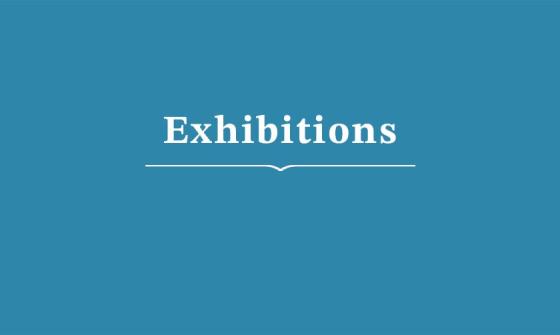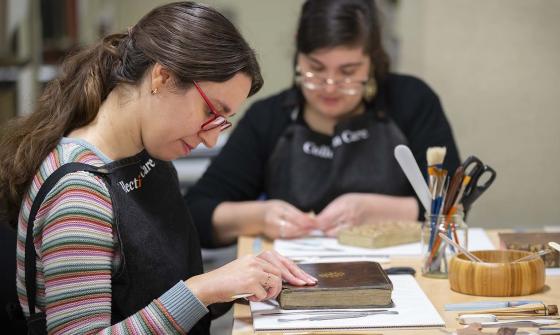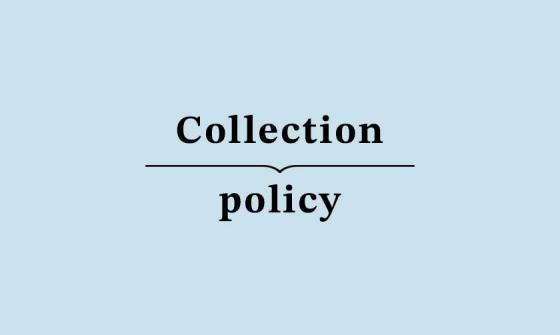Policy on the illumination of collection material on display
Introduction
The National Library of Australia Act 1960 provides the Library with a mandate to build a national collection of library material, including a comprehensive collection of material relating to Australia and the Australian people. The collections include books, journals, newspapers, maps, printed music, pictures, manuscripts and oral history recordings. The Act also requires the Library to make its collections available for use.
The need to balance the requirement to make the collection available for use and the responsibility to maintain the national collection for future generations is familiar territory for collection managers. When it comes to the display of collection material the issue of exposure to light is of particular importance.
Displaying collections, both in formal exhibitions and in reading rooms, enables Library users to interact with Library collections in a meaningful way. This Policy on the Illumination of Collection Items on Display (Illumination Policy) is intended to help inform decision making about the way in which Library collections are exposed to light through exhibitions.
Damaging effects of light
Light causes damage to library collections and its effect is cumulative and irreversible. The damage is not always visible since the chemical structure of the item is being affected. Visible signs of damage include a change in colour (yellowing, bleaching or darkening) and embrittlement of organic materials such as cellulose fibres. Museum lighting requirements and the effects of light on museum objects have been well documented.
The Library limits the amount of damaging ultra violet (UV) light falling on collection items when they are being exhibited by using UV filters and low UV emitting light sources. Whilst collections that are accessed in reading rooms are exposed to light over a brief period, items on exhibition are exposed to light for extended periods. When making decisions about the amount of time an item may be exposed to light the Library takes into account the significance of a collection item, the sensitivity of its media to light and the impact that fading will have on the collection item.
For example: Thomson, G. The Museum Environment. 2nd ed. London: Butterworths, 1986.
CIE Technical Report: Control of Damage to Museum Objects by Optical Radiation; CID: 2004,
Significance
The significance of collection items is determined by the collection manager and may relate to the following aspects :
- Historic significance
- Artistic or aesthetic significance
- Research potential
- Provenance
- Rarity or representativeness
- Condition or completeness
Sensitivity of media
The sensitivity of media to light and the subsequent fading of the colours in a collection item is one of the factors considered when establishing the acceptable amount of light exposure for a collection item.
The use of the ISO rating, or Blue Wool (BW) Standard, enables a comparison of the fading that occurs to various types of media. BW 1 is the most responsive to light (meaning it fades the quickest); BW 2 is approximately half as responsive as BW1; and so on to BW 8 which is the least responsive. The media used in collections can be broadly grouped using their likely responsiveness to light. For example pristine condition watercolours are categorised as BW1 items. They will fade very quickly when exposed to light.
Most colours fade exponentially slower as fading progresses. Items in ‘pristine’ condition will have visible colour fading much more quickly than items that have already been exposed to a lot of light.
When the change in colour, or fading, of a collection item is visible to the eye it is described as a Just Noticeable Fade (JNF). By combining the Blue Wool standard (the responsiveness of media to light) with the JNF concept (the amount of fading) we can estimate the amount of light that a collection item of particular media can be exposed to before it is noticeably faded. If an item experiences 10 JNF then the item is likely to be no longer exhibitable because of the amount of fading or discolouration that will have occurred.
The assignment of objects into classifications according to light sensitivities is an imprecise science. Appendix 1 provides some examples of the relative sensitivity of collection items to light fading based on their media type.
Limiting damage
In order to reduce damage caused by exposure to light, the Library carefully monitors and limits the exposure of collection items to light. The Library’s Illumination Policy is that collection items will generally receive a level of illumination which produces one perceptible change within 50 years. (The table in Appendix 2 indicates how long a collection item may be on exhibition based on its Blue Wool media category and the amount of light that it is being displayed under.)
This amount of illumination exposure aims to balance the rights of access for current users of Library material, and potential future users.
Applying this policy requires flexibility and discussion between Collection Managers , Preservation and Exhibitions staff. In some cases items will be displayed for longer than the recommended time. These decisions will impact the longevity of the items displayed. Decisions about illumination limits will be made by taking account of all risks such as:
- Significance of the item
- Significance of colour to the item (some aspects of an item may be allowed to fade if they are not considered integral to the significance of the item)
- Existence of duplicate or equivalent items in the collection
- Amount of light fading that has already occurred to item (the rate of fading of media slows over time)
- Short term requirement for display if item will not be displayed for many years afterwards
- Availability of surrogates
- Other organisational reasons that need to be considered.
Exposure ratings
The following four categories will be used when discussing illumination limitations of Library collections:
- Individually Assessed: collection items that will not normally be on display but may be accessed in Reading Rooms. This includes highly significant items, extremely light sensitive items or items in pristine condition where the colour information is of particular value.
- Short Exposure: collection items which are light sensitive and should be displayed only for limited periods under standard 50 lux lighting conditions.
- Long Exposure: collection items which are relatively insensitive to light and can be on permanent display at reasonably high illumination levels of up to 200 lux.
- Permanent Exposure: collection items where light plays no role in their deterioration and for which the lighting levels should be determined by other factors.
Significance 2.0: a guide to assessing the significance of collections, Collections Council of Australia Ltd (2009)
Ford, B and Smith, N. 2009. The development of a significance and risk based lighting framework at the National Museum of Australia. AICCM Bulletin vol. 32, pp. 80-86
ISO, 1995. ISO105-B08 – 1995. Textiles – Tests for colour fastness. 1995.
Just Noticeable Fade (JNF) is the amount of colour loss (both in hue and lightness) that can be measured and is equivalent to one unit of ΔΕ*ab, CIE Technical Report p9
| Highly significant collection item | Moderately significant collection item | Lower significance collection item | |
|---|---|---|---|
| Highly sensitive to light fading (BW 1 – 3) | Individually assessed | Short Exposure | Long Exposure |
| Moderately sensitive to light fading (BW 4-6) | Short exposure | Long exposure | Permanent exposure |
| Low sensitivity to light fading (BW 7 – 8) | Long exposure | Permanent exposure | Permanent exposure |
Figure 1. Collections exposure matrix
Methods of controlling exposure
Many items in the Library’s collections are in the short exposure category. The following strategies will be used to minimize damage by reducing exposure to light:
- Selecting several different items on the same subject or from the same creator which can be displayed consecutively during the length of the exhibition.
- Displaying several different pages from the same bound collection item.
- Where more than one copy of a collection item exists selecting a particular copy as the ‘exhibition’ copy, therefore keeping at least one copy which is not exhibited.
- Using lighting solutions which reduce the light falling on an item such as sensor activated switches, drawers where the item is only lit when people are actively viewing it, low light levels.
- Following good practice for collection handling by ensuring items are not left uncovered in reading rooms, the conservation laboratory and other work areas for extended periods of time. Office areas in the Library are more brightly lit than standard exhibition galleries.
- Ensuring that a variety of collection items are used for special VIP events. This will require staff preparing a number of different ‘stories’ that can be told using items from the collection.
Review
The Manager of the National Library’s Preservation Services section is responsible for leading the coordinated implementation of this Illumination Policy. The implementation of the Policy will be overseen by the Preservation, Exhibitions and Special Collections (PESC) liaison meetings and an operational review of the Policy will be conducted in 12 months time. Thereafter, the Policy will be reviewed every three years.


